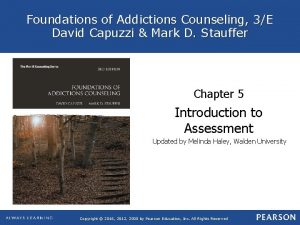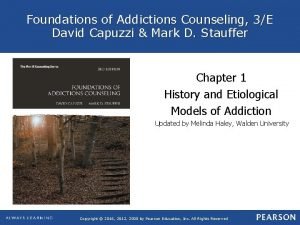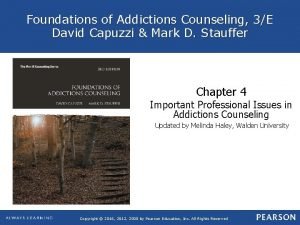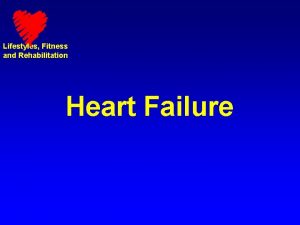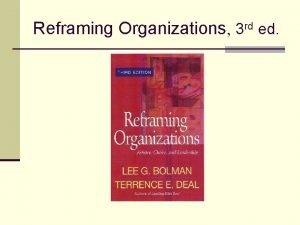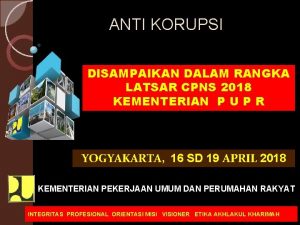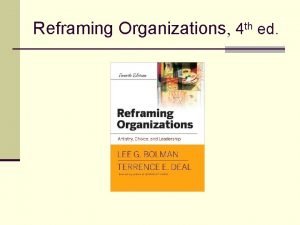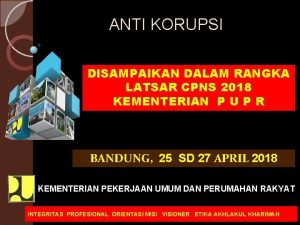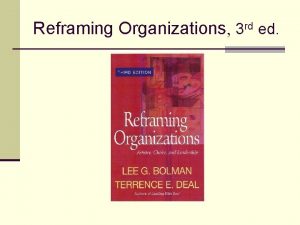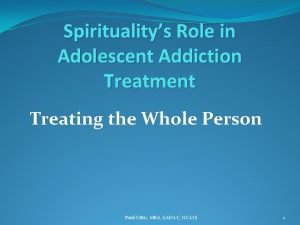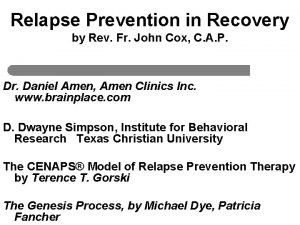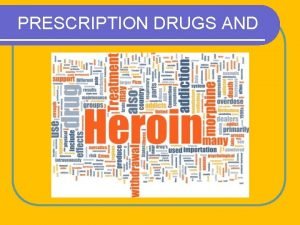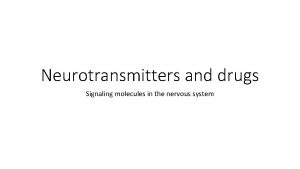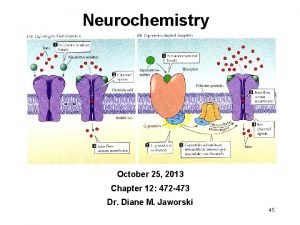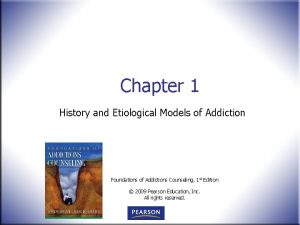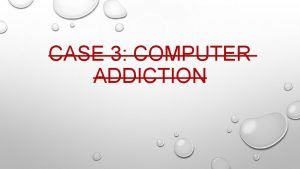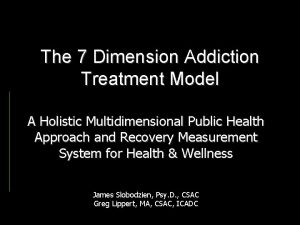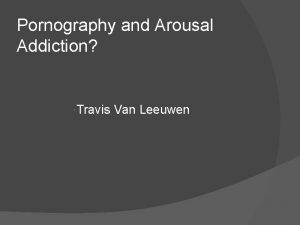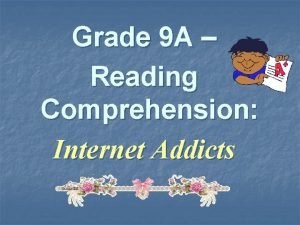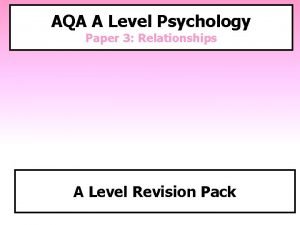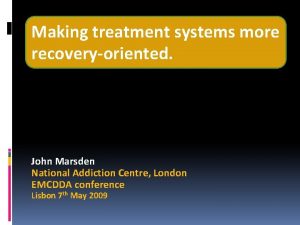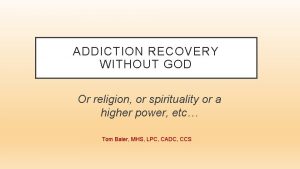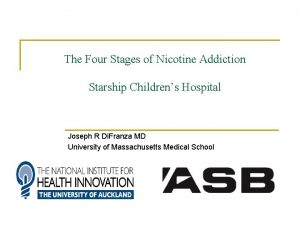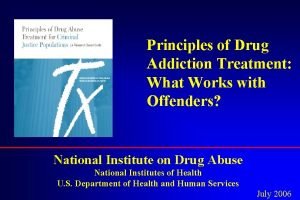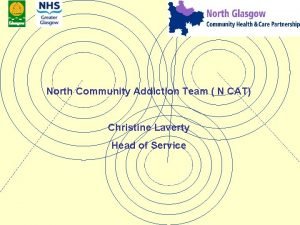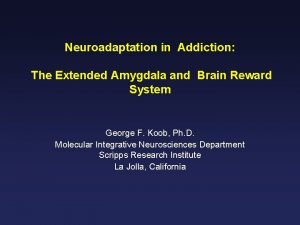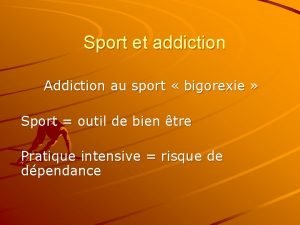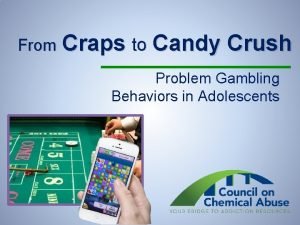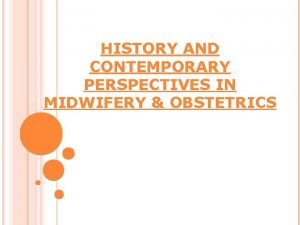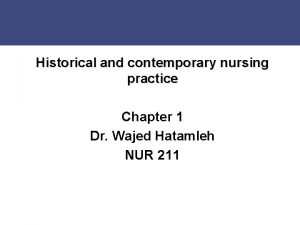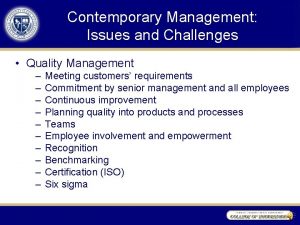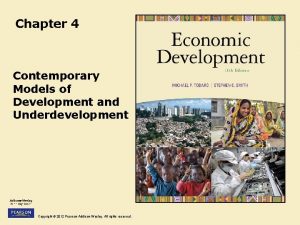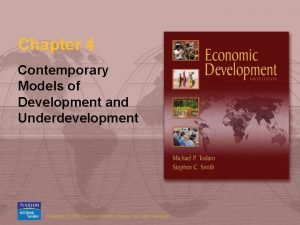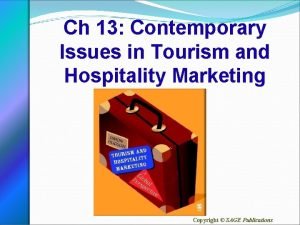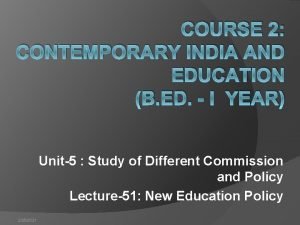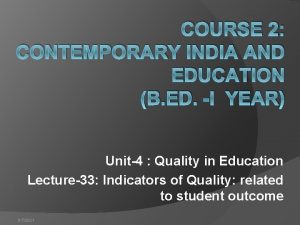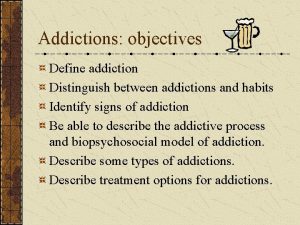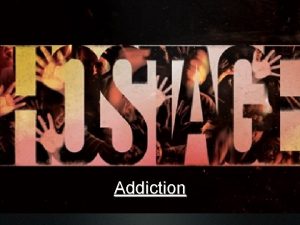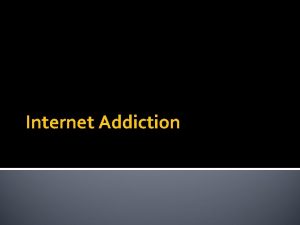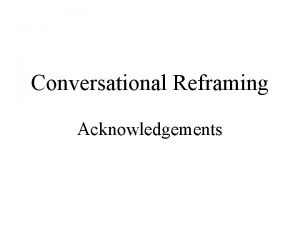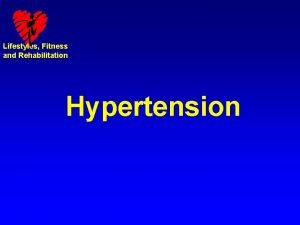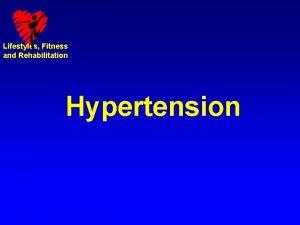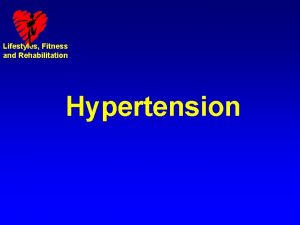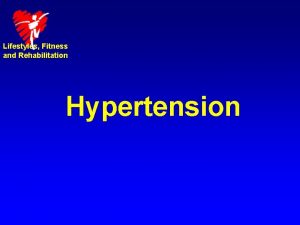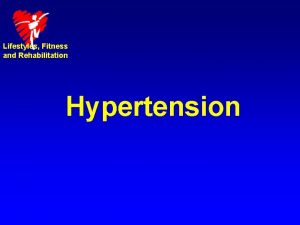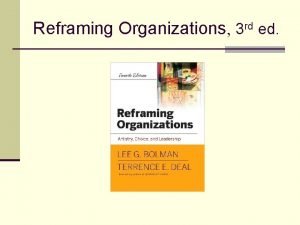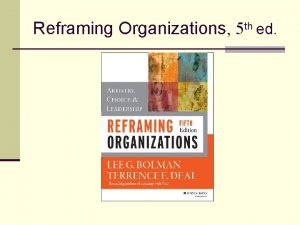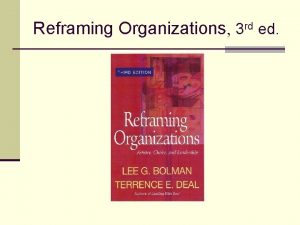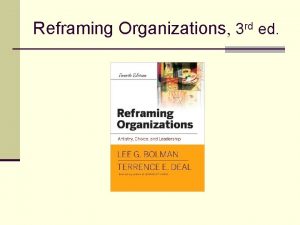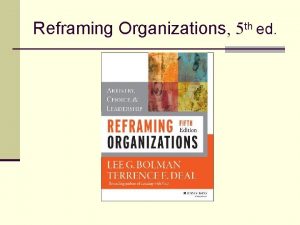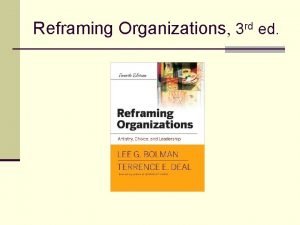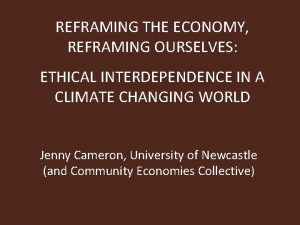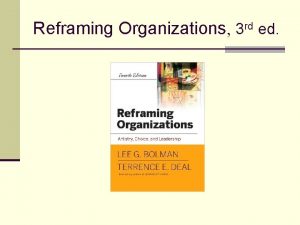Addiction and Lifestyles in Contemporary Europe Reframing Addictions






















































- Slides: 54

Addiction and Lifestyles in Contemporary Europe - Reframing Addictions Project Gerhard Bühringer Jürgen Rehm Sarah Forberger Anne-Marie Frommelt Silke Behrendt ziel Forschungskolloquium Dresden, den 23. 05. 2012

Fakultätsname XYZ Fachrichtung XYZ Institutsname XYZ, Professur XYZ ALICE RAP – über 200 Wissenschaftler, 21 Teilprojekte, 5 Jahre Forschung zu psychotropen Substanzen und Glücksspielen: Wird die Welt jetzt besser? Foko, 13. 01. 2015, Dresden Gerhard Bühringer, Silke Behrendt, Sarah Forberger, Maria Neumann, Charlotte Probst, Jürgen Rehm

1. 2. 3. 4. Introduction and overview WA 2: Classifying, Counting and Costing Addiction (JR) WA 3: Determinants of Addiction (GB) WA 4: Business of Addiction (SF) WA 5: Governance of Addiction 5. Conclusions 3

1. Introduction and overview 1. 1 Project aim To provide scientific evidence to promote public dialogue and stimulate debate around current issues and alternative options in relation to drug and addiction policy, from a multidisciplinary perspective. 4

1. Introduction and overview 1. ALICE RAP 1. 2 Why reframing? 5

1. ALICE RAP 1. Introduction and overview 1. 3 ALICE-RAP facts • 25 countries • 43 participating institutions • around 200 scientists • 21 work packages • 5 years (2011 -2016) • Budget: 7, 978, 226. 00 € 6

1. Introduction and overview 1. ALICE RAP 1. 4 Project structure 7

1. Introduction and overview 1. ALICE RAP 1. 5 Core characteristics of ALICE RAP • to compile and integrate scientific evidence from a multidisciplinary perspective • to promote public dialogue • to support societal action to improve substance (and gambling) policy, on the ground of scientific evidence 8

Fakultätsname XYZ Fachrichtung XYZ Institutsname XYZ, Professur XYZ 2. WA 2: Classifying, Counting and Costing Addiction Work Area 2 Lead: Jürgen Rehm (TUD), Gerhard Gmel (CH), Krzysztof Brzózka (P) 1) Rev. 05. 10. 2015

2. 1 Classifying -> Checkered history of definitions: WHO 1957 habituation vs. addiction Addiction (heroin et al. ) • WHO Expert Committee on Addiction. Producing Drugs, Seventh Report Habituation (Alcohol, tobacco)

Heavy use over time as new definition of addiction ltural ). Cu Lancet. 5 1 0 , R. (2 ders. Room l use disor i: & , . , J ho do Rehm ity in alco t Sep 3] 3 -3 n c i i r f i 1 p c )00 2 spe d of 5 a 1 ( e 6 h a 73 [Epub 6/S 0140 -6 1 0 1 10.

What did we find in Alice Rap? 1. Heavy use over time is responsible for the changes in the brain, and other physiological characteristics of substance use disorders. 2. Heavy use is responsible for intoxication, and for the withdrawal and tolerance phenomena regarded as central to current definitions of addiction or dependence. 3. Heavy use over time is responsible for the main social consequences of substance use disorders such as problems in fulfilling social roles. 4. Heavy use over time is responsible for the majority of the substance-attributable burden of disease and mortality. 5. Heavy use over time as a definition better fits the empirical data and will eliminate some of the current problems with definitions and operationalizations.

How many deaths are attributable to heavy drinking? 25 Percentage of deaths 20 15 10 5 0 Men Women Total Alcohol-attributable 16. 1% 8. 5% 13. 6% Alcohol-attributable (net) 13. 9% 7. 7% 11. 8% Men Women Heavy drinking 11. 1% 5. 3% 9. 2% Alcohol dependence 10. 7% 3. 7% 8. 4% Total Rehm et al Eur Neuropsychopharm 2013

Stigmatization and thresholds – heavy drinking as definition may reduce stigmatization • the problem of groups (Nomal Group Theory Tajfel) • it is harder to stigmatize against a continuum where we are all part of • the key is to stress the continuum and de-emphasize thresholds!

How did we find this? Interviews with experts from various disciplines Quantitative and qualitative analyses Consensus conference of interdisciplina ry team

2. 2 Counting -> Impact of substance use in the EU 2013 Risk factor Sex Illicit drug use Men YLLs per 100, 000 % of all YLLs DALYs per 100, 000 % of all DALYs 1069. 8 428. 5 2. 45% 1749. 2 700. 7 2. 31% Women Total 292. 7 1362. 5 111. 9 266. 6 0. 95% 1. 83% 580. 5 2329. 7 222. 0 455. 8 0. 84% 1. 61% Alcohol consumption Men 4558. 7 1826. 1 10. 45% 5981. 4 2396. 0 7. 91% Women Total 1584. 0 6142. 8 605. 8 1201. 9 5. 14% 8. 25% 2019. 8 8001. 2 772. 5 1565. 5 2. 92% 5. 53% Tobacco use Men 10036. 4 4020. 3 23. 00% 11280. 0 4518. 5 14. 94% Women Total 3552. 2 13588. 6 1358. 6 2658. 6 11. 52% 18. 25% 4405. 0 15685. 0 1684. 7 3068. 8 6. 37% 10. 85%

Proportion of substance-attributable burden of all burden EU 2013 Years of life lost

Proportion of substance-attributable burden of all burden EU 2013 DALYs 16. 0% 14. 0% 12. 0% 10. 0% 8. 0% 6. 0% 4. 0% 2. 0% 0. 0% M W T Illicit Drugs M W T Alcohol M W T Tobacco

2. 3 Costing -> cost study in Catalonia, Poland Portugal • Traditional cost of illness study with standard results below 1% of GDP. • Problems of comparability: • Different availability of data • Different health care systems and legal systems => Apples are compared with pairs (or even oranges) • Avoidable cost study: reduction of consumption; minimum price for alcohol. • In depth comparison of legal systems and costs: Portugal is least legal costs. • Conclusions are hard to draw.

3. Determinants of addiction 1. ALICE RAP 3. 1 Zielsetzung und Arbeitsplan (1) Determinants of transitions to the three stages of problem development No/low risk Risky Harmful No/low risk use/gambling Disciplines Areas of determinants Public policy, economics, sociology, youth studies, anthropology, psychology, neurobiology, marketing, genetics, history Social, economic and political environment Individual characteristics Cellular and molecular factors (including substance/gambling characteristics) 20

3. Determinants of addiction 1. ALICE RAP 3. 1 Zielsetzung und Arbeitsplan (2) Anthropology Economics Genetics History Marketing Discipline papers Neurobiology Psychology Public Policy Sociology (Youth studies) Synthesis reports • Integration of discipline reports Model reports • Interdisciplinary models • Transition probabilities • Implications for policy and research 21

3. Determinants of addiction 1. ALICE RAP 3. 2 Definitionen (1) Determinants “ ‘Determinants’ is used to describe a range of factors at the molecular and cellular, individual, and social, economic and political environment levels which, alone or together, increase or decreases the likelihood of risky or harmful substance use or gambling, or reductions/ cessation of such activities. To use the word determinant does not mean that any of these factors or combination of factors are deterministic in a causal manner. ” 22

3. Determinants of addiction 1. ALICE RAP 3. 2 Definitionen (2) Risky use/ gambling All expressions of substance use and gambling, in terms of quantity, frequency, pattern, and situational circumstances which are material predictive factors for short- or long-term individual harm, or harm to others including society at large. Harmful use/ gambling Substance use or gambling which has caused material harms of social, mental, or physical nature which are experienced by the user, other individuals, or society at large. No/ low risk use/ gambling Material reductions in harms of a social, mental, or physical nature which are experienced by the user, other individuals, or society at large, which is related to remission or reduction in substance use or gambling. 23

3. Determinants of addiction 1. ALICE RAP 3. 3 Beispiel: Ein Beitrag der Psychologie (1) Warum natürlicher Verlauf von CU und CUD? • Hohe Lebenszeit-Prävalenz im Vergleich zu anderen illegalen Substanzen • Dritthäufigste Hauptdiagnose im dt. Versorgungssystem (Vgl. europäischer Schnitt) • Bezug zu CANDIS • wenig Studien über natürlichen Verlauf nach Konsumbeginn • Kritik an methodischer Qualität von epidemiologischen Studien zu Prädiktoren von Substanzstörungen (Perkonigg & Wittchen, 1996) Warum Verlauf nach Konsumbeginn? • Häufig: Beendigung des Konsums nach Experimentieren Prädiktoren für Konsumbeginn ≠ Prädiktoren für schweren Konsum/Substanzstörungen • Hohe Remissionszahlen, aber wenig Wissen über Prädiktoren für Spontanremission • Wissen für bessere Interventionen nutzen 24

3. Determinants of addiction 1. ALICE RAP 3. 3 Beispiel: Ein Beitrag der Psychologie (2) (a) Populationsbasierte Stichprobe (b) Längsschnittstudien mit prospektivem Design (c) Mindestbeobachtungszeitraum 6 Monate (d) Cannabisspezifische Ergebnisangaben (vs. z. B. ‘illegale Substanzen’) (e) Angaben zu initialem Status von Cannabiskonsum/störungen (CK/CS) (f) Zielvariable ist Veränderung oder Stabilität des initialen CK/CS-Status 25

3. Determinants of addiction 1. ALICE RAP 3. 3 Beispiel: Ein Beitrag der Psychologie (3) Methodik Standard PRISMA (Moher, Liberati, Tetzlaff, & Altman, 2009) Suchperiode 1993 - 03/2014 Datenbanken Web of Knowledge Scirus (Pubmed, Psydoc, Science. Direct, Sage, others)/ Psy. Index, Pub. Med Suchbegriffe (modifiziert nach PICOS) ‘cannabis use’ OR `cannabis use disorder*’ OR ‘marijuana use’ OR `marijuana use disorder*’ AND ‘natural history’ OR ‘natural course’ OR ‘onset’ OR ‘manifestation’ OR ‘progression’ OR ‘remission’ OR ‘recovery’ OR ‘cessation’ OR ‘relapse’ AND 26 ‘prospective’ OR ‘longitudinal’ OR ‘follow-up’ OR ‘epidemiol*’

3. Determinants of addiction 1. ALICE RAP 3. 3 Beispiel: Ein Beitrag der Psychologie (4) Qualitätsindex (adaptiert nach Calabria, 2010) Insg. 20 Punkte 27

3. Determinants of addiction 1. ALICE RAP 3. 4 Stufen des Integrations- und Reduktionsprozesses (1) Key for the determinants listed on the following logic models Sociology Anthropology Public policy Marketing Economics Psychology Neurobiology Genetics 28

3. Determinants of addiction 1. ALICE RAP 3. 4 Stufen des Integrations- und Reduktionsprozesses (2) 29

3. Determinants of addiction 1. ALICE RAP 3. 4 Stufen des Integrations- und Reduktionsprozesses (3) 30

3. Determinants of addiction 1. ALICE RAP 3. 4 Stufen des Integrations- und Reduktionsprozesses (4) 31

3. Determinants of addiction 1. ALICE RAP 3. 4 Stufen des Integrations- und Reduktionsprozesses (5) 32

3. Determinants of addiction 1. ALICE RAP 3. 4 Stufen des Integrations- und Reduktionsprozesses (6) 33

3. Determinants of addiction 1. ALICE RAP 3. 5 Final heuristic model Individual vulnerabilities Environmental factors • • Availability, access, marketing Family and peer group • • • Neurobiology Learning & motivation Cognitive Control ? Lack of knowledge (probably both factor groups) Substance/ Behaviour characteristics Time line No/low risk use Risky use Harmful use No/low risk use Chronic relapse 34

3. Determinants of addiction 1. ALICE RAP 3. 6 Übergangswahrscheinlichkeiten: gleichzeitige Berücksichtigung wichtiger Risikofaktoren Wie hoch sind die Übergangswahrscheinlichkeiten zwischen Abstinenz, wenig riskantem Alkoholkonsum (Konsum), gelegentlichem Rauschtrinken (1 -8 pro Monat; GRT) und häufigem Rauschtrinken (3+ pro Woche; HRT)? • • Längsschnittliche Daten (N=3021) mit drei Erhebungszeitpunkten Markov Modell zur Berechnung jährlicher Übergangswahrscheinlichkeiten und hazard ratios (HR) für Geschlecht, Alter und sozioökonomischen Status (SES) Follow-up Baseline Abstinenz Konsum GRT HRT Abstinenz 79. 1% 17. 8% 3. 0% 0. 1% Konsum 6. 4% 73. 9% 19. 0% 0. 7% GRT 1. 1% 25. 6% 67. 8% 5. 5% HRT 0. 1% 3. 6% 19. 4% 76. 9% Geringere Übergangswahrscheinlichkeit für Frauen bei höherem Alter Geringere Höhere Übergangswahrscheinlichkeit für Frauen bei hohem SES Probst, C. , Moyo, D. , Purshouse, R. , & Rehm, J. (2015). Transition probabilities for four states of alcohol use in adolescence and young adulthood: what factors matter when? Addiction, 110(8), 1272 -1280. 35

3. Determinants of addiction 1. ALICE RAP 3. 6 Übergangswahrscheinlichkeiten: gleichzeitige Berücksichtigung wichtiger Risikofaktoren Auf Grundlage des Modells vorhergesagte geschlechts- und altersspezifische Wahrscheinlichkeiten für Abstinenz und die verschiedenen Konsummuster Fazit: Übergangswahrscheinlichkeiten lassen sich von der Methodologie her gut modellieren. Jedoch ist die Anzahl der Faktoren, die sich modellieren lassen begrenzt. Es nützt deshalb wenig, riesige Listen von potentiellen Einflussfaktoren auf Ü. zu entwickeln –> statt dessen müsste theoretisch gearbeitet werden mit wenigen Schlüsselfaktoren und deren Interaktionen. Probst, C. , Moyo, D. , Purshouse, R. , & Rehm, J. (2015). Transition probabilities for four states of alcohol use in adolescence and young adulthood: what factors matter when? Addiction, 110(8), 1272 -1280. 36

3. Determinants of addiction 1. ALICE RAP 3. 7 Schlussfolgerungen (1) Developmental approach (2) Transition-specific impact of environmental, individual and substance/ gambling-specific characteristics (3) Reduction/ cessation of harmful use/ gambling often occurs without formal help-processes and factors are under researched (4) Multidisciplinary approach to integrate core scientific findings (5) Implications for policy • interventions at environmental and individual levels • stage-specific interventions 37

3. Determinants of addiction 1. ALICE RAP 3. 7 Schlussfolgerungen (2) (6) Implications for research needs • risky use/ gambling characteristics • interactions of factors • natural recovery (7) Limitation: No time/consensus to reduce large number of factors to theory-driven, testable models (8) Lack of data for core factors to be included in risk models 38

4. WA 4: Business of Addiction 1. ALICE RAP 1. Introduction and overview 4. 1 Gefängnisinterviews (1) Ziel • Informationen zu allen Aspekten des Handels/Schmuggels mit Heroin/Kokain (Einstieg, Handelsstrukturen, Geschäftsabläufe, Kosten, Profit, Rolle gesetzlicher Strukturen) Kooperationspartner • Emma Disley (RAND Europe), UK • Alice Rena – United Nations Interregional Crime and Justice Research Institute (UNICRI)), Italien • Sanela Talic (Institute for research and development (Utrip)), Slowenien 39

4. WA 4: Business of Addiction 1. ALICE RAP 1. Introduction and overview 4. 1 Gefängnisinterviews (2) Methodik • Nicht-repräsentative, multizentrische, nichtinterventionelle Studie • Semistrukturelle Befragung verurteilter männlicher Heroin/Kokain Händler/Schmuggler • Gefängnisse in Deutschland, Italien, Slowenien 40

4. WA 4: Business of Addiction 1. ALICE RAP 4. 2 Ergebnisse (1) Italien Slowenien Deutschland Teilnehmende Gefängnisse 5 3 8 Anzahl der Interviews 72 44 19 25 -45 25 38 14 46 - 15 Keine Angabe 32 6 2 Dealer 72 31 12 Schmuggler 2 Keine Angabe 3 Alter 3 Tätigkeit Beides 3 Anderes 1 41

4. WA 4: Business of Addiction 1. ALICE RAP 1. Introduction and overview 4. 2 Ergebnisse (2) Italien Slowenien Deutschland Hauptdroge vs. Einstiegsdroge Haupt. Einstieg Kokain 43 37 9 4 7 5 Heroin 11 17 10 10 6 5 Beides 9 - 24 - 6 - Cannabis/Haschisch 8 15 - - Synthetische Drogen - - 1 2 - 1 1 - - Andere Keine Angabe - 3 2 42

4. WA 4: Business of Addiction 1. ALICE RAP 1. Introduction and overview 4. 2 Ergebnisse (3) Italien Slowenien Deutschland Ökonomische Gründe 29 6 10 Finanzierung Eigenkonsum 14 6 10 Heranführung durch Freunde 31 6 18 Bekannte von früheren Haftstrafen - - 3 Familie - 1 Gründe Handel/ Schmuggel Karriereverlauf – Vergleich Menge der Verkauften Drogen bei Beginn und vor Verurteilung Italien (N=65) Slowenien (N=37) Deutschland (N=17) Mehr Verkauft 43 (66. 2%) 29 (78. 4%) 9 (52. 9%) Gleich viel Verkauft 17 (26. 2%) 2 (5. 4%) 5 (29. 4%) Weniger Verkauft 5 (7. 6%) 6 (16. 2%) 3 (17. 7%) 43

4. WA 4: Business of Addiction 1. ALICE RAP 1. Introduction and overview 4. 2 Ergebnisse (4) Italien Slowenien Deutschland 18 (davon 14 kein Strassenverkauf) 4 1 52 27 14 Haupteinkommenserwerb 43 davon 19 davon 4 Einzige Beschäftigung 36 17 High Level Dealer/Low Level Dealer High Level Dealer (>10 kg/Monat) Low Level Dealer (<10 kg/Monat) Haupteinkommenserwerb Dealen/Schmuggel Andere Anstellung als Haupteinkommenserwerb 23 13 44

4. WA 4: Business of Addiction 1. ALICE RAP 1. Introduction and overview 4. 3 Schlussfolgerungen • Diskrepanz zwischen Wissen über Risikomanagement und Verhalten • keine hierarchische Wissenskanäle • Hinweise für Prävention: auf früheres Handeln/Straftaten achten • § 31 (Kronzeugenparagraph) wirksam 45

4. WA 4: Business of Addiction 1. ALICE RAP 1. Introduction and overview 4. 4 Erfahrungen aus der Studie • Herausforderung bei der Organisation der Studien (Übersetzung des Fragebogens, implizite Herangehensweise an das Thema, unterschiedliches Verständnis von Wörtern) • Zugang zu Gefängnissen und Auswahl der Gefangenen sehr unterschiedlich • Unterschiedliche Anforderungen der Ethikkommission 46

4. WA 5: Governance of Addiction 1. ALICE RAP 1. Introduction and overview 4. 5 Buchpublikation Zielsetzung • Analyse des Umgangs von Gesellschaften mit Abhängigkeitserkrankungen (Gesamt-WP) • Veröffentlichung eines Buches (TUD-Teil) Aufgabe • Analyse von Prozessen und Einflussfaktoren bei der Gestaltung und Steuerung (governance) des gesellschaftlichen Umgangs mit psychotropen Substanzen/ Glücksspielen • Kriterien für solche Gestaltungs- und Steuerungsprozesse 47

4. WA 5: Governance of Addiction 1. ALICE RAP 1. Introduction and overview 48

4. WA 5: Governance of Addiction 1. ALICE RAP 1. Introduction and overview 49

5 Conclusions 1. ALICE RAP 1. Introduction and overview 5. 1 Summary: core results (1) Heavy use over time to replace terms like “addiction” (2) Reduce social stigma to remove barriers for help (3) Policies to consider evolutionary behaviour (4) Policies to consider societal well-being in relation to substances and gambling (5) Policies to consider toxicology-based margins of exposure analysis (6) Policies to reduce heavy use 50

5 Conclusions 1. ALICE RAP 1. Introduction and overview 5. 1. Summary: core results (2) (7) Policies to recognise the vulnerability of adolescent brains (8) Policies to reduce the gap between support needs and provisions (9) Policies to assess prevention programmes for cost-effectiveness like treatment (10) Policies to integrate whole-of-governments and whole-of-society approaches (11) Policies to be independent of producers and service providers (12) Policies to consider the “health footprint” as a component to measure and reduce harm (e. g. DALYs) 51

5 Conclusions 1. ALICE RAP 1. Introduction and overview 5. 2. Gambling: reaction of others • High interest of EU and German agencies • Transition-specific interventions • Interest in a set of proposals for regulations, prevention and treatment 52

5. 3 Substances: reactions of others Fakultätsname XYZ Fachrichtung XYZ Institutsname XYZ, Professur XYZ This was a EU project: what was the reaction of the EU? • We were in Brussels once for an interim report. No overwhelming reactions; polite interest. • Usual bureaucracy, softened by an efficient team in Barcelona. • Politically, the stuff with BMJ was the most problematic (“under the influence”) =>The views expressed here reflect only the authors’ and the European Union is not liable for any use that may be made of the information contained therein. • Special demands of EU, e. g. for gambling. European Commission refuses to pay for ‘ad hominem attack’ 25 Nov 2014 The European Commission has refused to fund a series of articles published in the British Medical Journal (BMJ) which attacked critics of minimum pricing, the Department for Business Innovation and Skills has confirmed. In January 2014, the BMJ published several articles by Jonathan Gornall, a freelance journalist, alleging that think tanks, including the Institute of Economic Affairs, were part of a campaign against minimum pricing that was funded and co-ordinated by the alcohol industry. Mr Gornall told interviewees that his project was “an EU-sponsored investigation” and the BMJ credited his funding to ALICERAP, a project that is co-financed by the European Commission. The Commission has since distanced itself from the articles and has now asked for its credit to be removed. John Duffy, a statistician specialising in alcohol and health, was one of the academics discussed by Mr Gornall. He subsequently wrote to the Department of Business, Innovation and Skills (BIS), complaining that the articles “amounted to little more than an ad hominem attack”. Duffy, who has authored dozens of academic studies in peer -reviewed journals, said that Mr Gornall’s description of his career was “laughably biased” …. .

5. 2 Lingering behind many reactions: UNGASS 2016 Fakultätsname XYZ Fachrichtung XYZ Institutsname XYZ, Professur XYZ EU delegation with Alice RAP input; WHO has been asking a special session to discuss Alice RAP findings in 2015 to prepare UNGASS (highly controversial discussions originally -> sustainable cooperation); sustainable development goals indicator on substance use treatment
 Substance use addictions and related behaviours
Substance use addictions and related behaviours Foundations of addictions counseling 3rd edition
Foundations of addictions counseling 3rd edition Foundations of addictions counseling
Foundations of addictions counseling Capuzzi and stauffer
Capuzzi and stauffer Yellow phlegm
Yellow phlegm Module 1 lifestyles
Module 1 lifestyles Grade 12 active healthy lifestyles
Grade 12 active healthy lifestyles Grade 11 active healthy lifestyles
Grade 11 active healthy lifestyles Grade 12 active healthy lifestyles
Grade 12 active healthy lifestyles Reframing organizational culture
Reframing organizational culture Identifikasi dan penyelarasan nilai anti korupsi
Identifikasi dan penyelarasan nilai anti korupsi Reframing organizations (doc or html) file
Reframing organizations (doc or html) file Teknik dasar konseling
Teknik dasar konseling Peran tunas integritas wow effect
Peran tunas integritas wow effect Nlp reframing
Nlp reframing Reframing organizations chapter 3 summary
Reframing organizations chapter 3 summary Spirituality and addiction
Spirituality and addiction Recovery zone sex addiction test
Recovery zone sex addiction test Fast scale
Fast scale Learn.genetics.utah/content/addiction/mouse
Learn.genetics.utah/content/addiction/mouse Http://learn.genetics.utah.edu/content/addiction/
Http://learn.genetics.utah.edu/content/addiction/ Epinephrine in the brain
Epinephrine in the brain Journal of neuroscience methods
Journal of neuroscience methods Models of etiology of addiction
Models of etiology of addiction Case 3 computer addiction
Case 3 computer addiction Addiction expert witness
Addiction expert witness The teap of ace
The teap of ace Arousal addiction
Arousal addiction Are you an internet addict reading comprehension
Are you an internet addict reading comprehension Filter theory psychology
Filter theory psychology 12 core functions and global criteria
12 core functions and global criteria Absorption addiction model
Absorption addiction model Addicted to sin
Addicted to sin Scratching addiction
Scratching addiction John marsden addiction
John marsden addiction Avrt addiction treatment
Avrt addiction treatment 4 stages of zyn addiction
4 stages of zyn addiction Nida principles of drug addiction treatment
Nida principles of drug addiction treatment Addiction vs compulsion
Addiction vs compulsion Community addiction team
Community addiction team Neuroadaptation definition
Neuroadaptation definition Cigie addiction
Cigie addiction Bigorexie definition
Bigorexie definition Candy crush betting
Candy crush betting Brenda z pancreatitis
Brenda z pancreatitis Historical and contemporary perspectives in midwifery
Historical and contemporary perspectives in midwifery Contemporary nursing practice meaning
Contemporary nursing practice meaning Contemporary management issues
Contemporary management issues Contemporary models of development and underdevelopment
Contemporary models of development and underdevelopment Contemporary models of development and underdevelopment
Contemporary models of development and underdevelopment Contemporary issues in tourism meaning
Contemporary issues in tourism meaning Course 2 contemporary india and education
Course 2 contemporary india and education Course 2 contemporary india and education
Course 2 contemporary india and education Course 2 contemporary india and education
Course 2 contemporary india and education Seminar on education in india
Seminar on education in india

